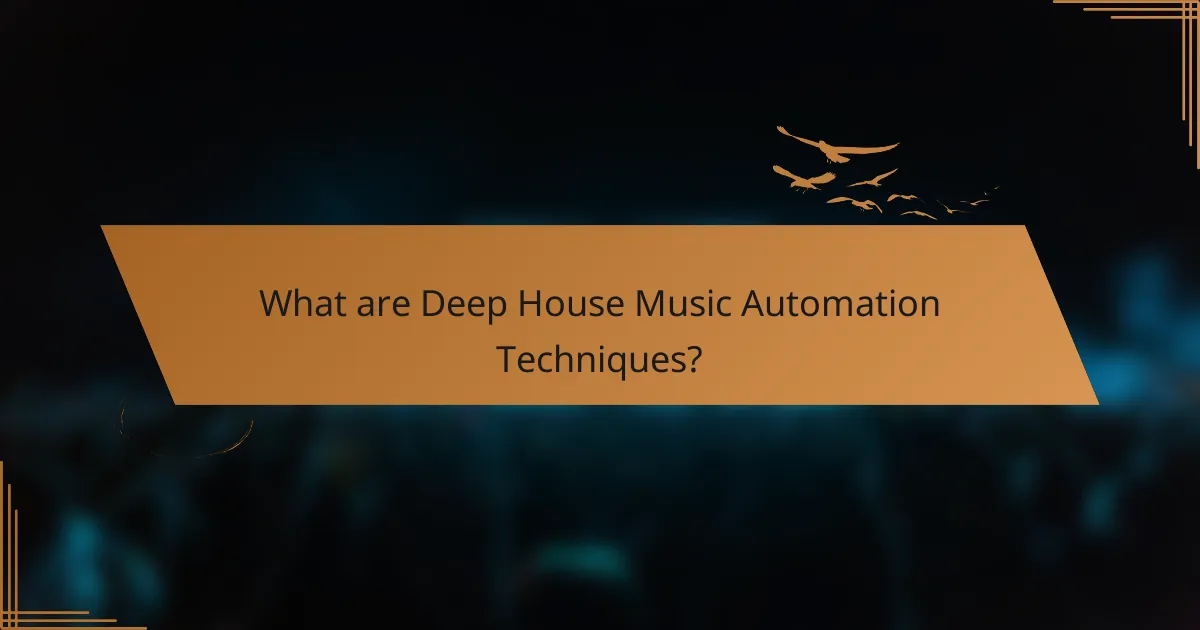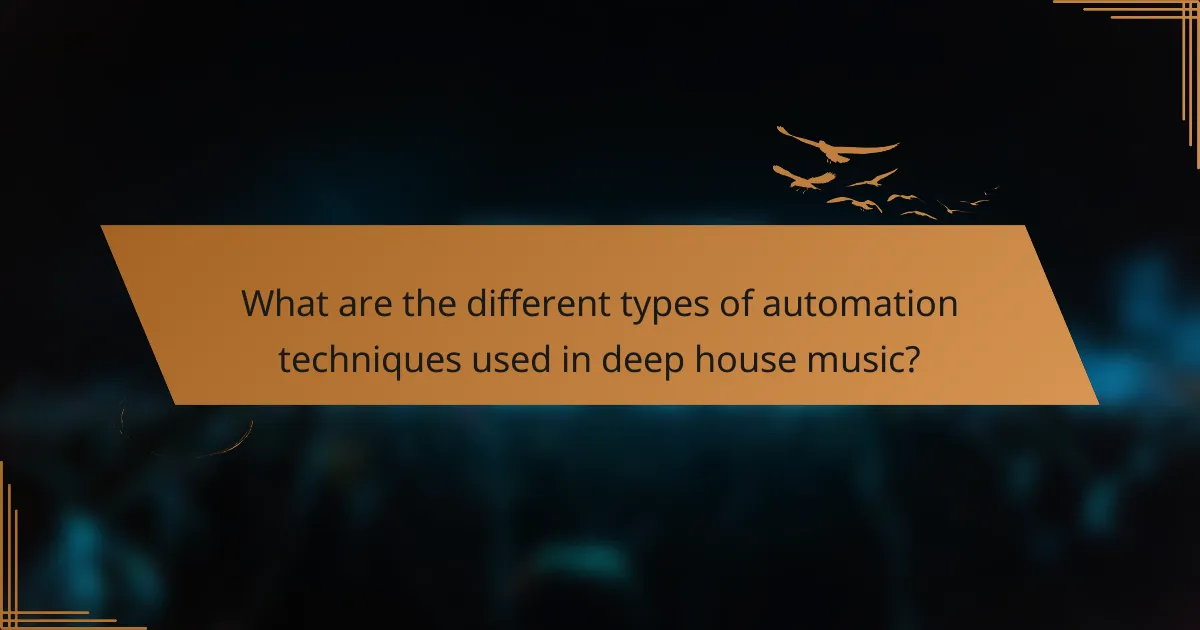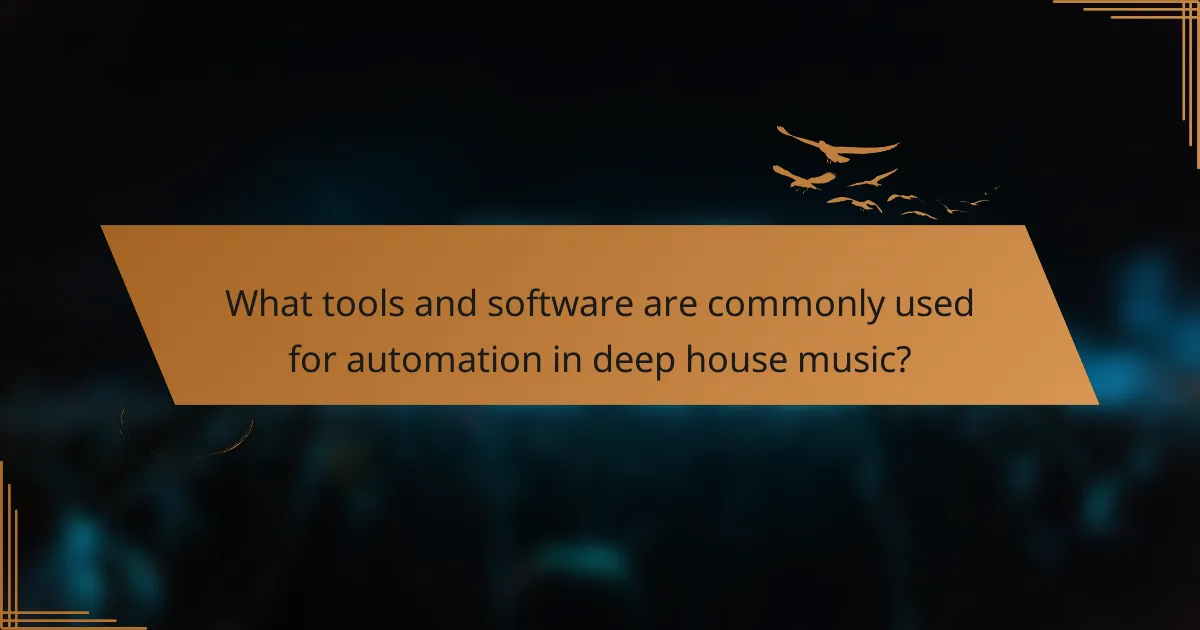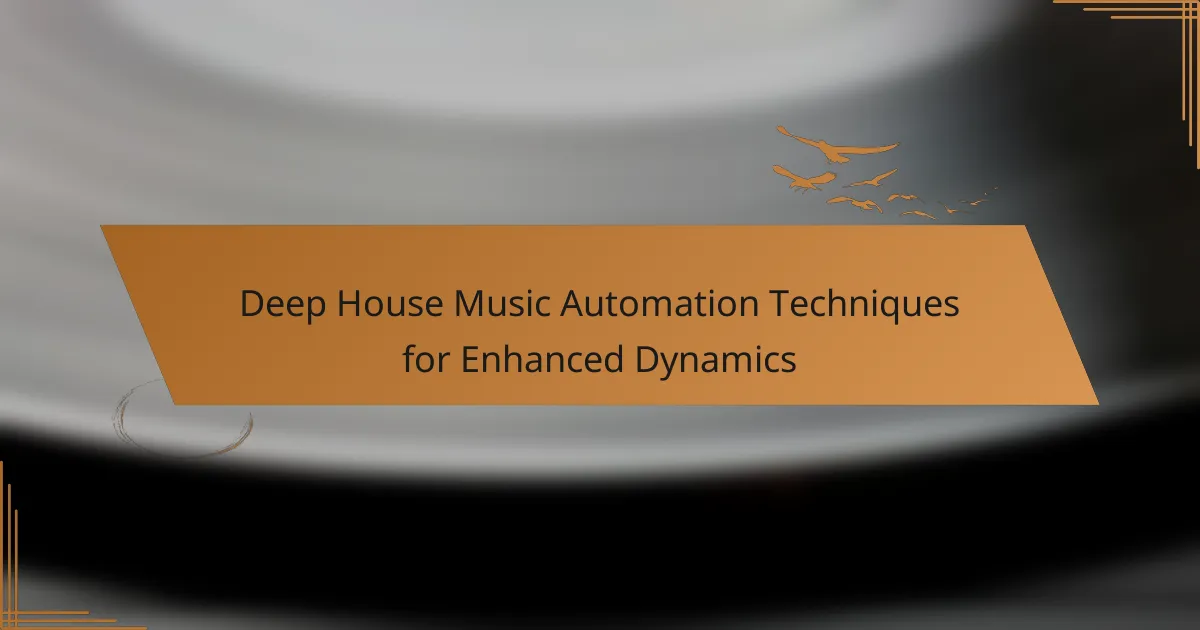Deep House Music Automation Techniques are essential processes used in music production to enhance sound dynamics. Key automation methods include volume automation for adjusting loudness, filter automation for modifying frequency responses, and effect automation for controlling audio effects like reverb and delay. These techniques contribute to creating dynamic shifts, evolving soundscapes, and polished tracks, significantly improving track quality and listener engagement. Common tools for implementing these automation techniques include digital audio workstations (DAWs) such as Ableton Live, Logic Pro, and FL Studio, along with synthesizer plugins like Serum and Massive.

What are Deep House Music Automation Techniques?
Deep House Music Automation Techniques involve the use of automated processes to enhance sound dynamics in music production. These techniques include volume automation, which adjusts levels over time, and filter automation, which modifies frequency responses. Additionally, panning automation shifts sound across the stereo field for spatial effects. Envelope automation shapes sound characteristics like attack and decay. Automation can also be applied to effects such as reverb and delay, creating evolving textures. These methods contribute to a more dynamic and engaging listening experience. Studies show that effective automation can significantly improve track quality and listener engagement in electronic music genres.
How do these techniques enhance musical dynamics?
Automation techniques enhance musical dynamics by allowing precise control over volume, panning, and effects throughout a track. These techniques create variations that add interest and movement to the music. For example, gradually increasing volume during a build-up can create tension. Conversely, automating a decrease in volume can lead to a smooth transition. Additionally, panning automation can create a sense of space and depth in the mix. Effects like reverb and delay can be dynamically adjusted to enhance specific elements at key moments. This results in a more engaging listening experience. Research shows that dynamic changes can significantly impact listener perception and emotional response.
What specific elements of deep house music benefit from automation?
Elements of deep house music that benefit from automation include synths, vocal effects, and percussion. Automation enhances synths by allowing dynamic changes in modulation and filter settings. This creates evolving textures and keeps the listener engaged. Vocal effects, such as reverb and delay, can be automated for varying intensity throughout a track. This adds emotional depth and maintains interest in the vocals. Percussion elements benefit from automation through volume adjustments and panning. This creates a sense of movement and groove within the track. Overall, automation plays a crucial role in shaping the sound and dynamics of deep house music.
How does automation influence the emotional impact of deep house tracks?
Automation enhances the emotional impact of deep house tracks by allowing precise control over sound dynamics. This technique enables producers to manipulate volume, effects, and modulation throughout a track. For instance, gradual volume changes can create tension and release, evoking strong emotional responses. Additionally, automation can adjust reverb and delay effects, adding depth and atmosphere. Studies show that dynamic changes in music significantly affect listener emotions. A research article by Juslin and Västfjäll (2008) highlights how musical dynamics influence emotional experiences. Therefore, effective use of automation in deep house music can amplify its emotional resonance.
Why are automation techniques essential in music production?
Automation techniques are essential in music production because they allow precise control over various elements of a track. This control enhances dynamics and creates a more polished sound. Automation can adjust volume, panning, effects, and other parameters over time. It enables producers to craft intricate soundscapes and transitions. For instance, automating a filter cutoff can create movement and interest in a mix. Studies show that tracks with automation often engage listeners more effectively. In genres like deep house, automation contributes to the genre’s characteristic ebb and flow. Thus, automation is a vital tool for achieving professional-quality music production.
What role does automation play in mixing and mastering deep house music?
Automation plays a crucial role in mixing and mastering deep house music. It allows producers to control various elements dynamically throughout the track. For instance, automation can adjust volume levels, panning, and effects over time. This creates movement and interest in the music.
In deep house, where subtlety and atmosphere are vital, automation helps to enhance the emotional impact. Producers can automate filter sweeps to build tension or release energy at key moments. Additionally, automation can be used to emphasize vocals or instrumental parts, ensuring they sit well in the mix.
According to a study by the Berklee College of Music, effective use of automation can improve the overall clarity and balance of a mix. This is essential in deep house, where layers of sound must coexist harmoniously. Thus, automation not only enhances dynamics but also contributes to the genre’s signature sound.
How can automation improve the overall sound quality of a track?
Automation can improve the overall sound quality of a track by allowing precise control over various elements. It enables adjustments in volume, panning, and effects at specific moments. This results in a more dynamic and engaging listening experience. For instance, volume automation can enhance the presence of certain instruments during key sections. Additionally, automation can create smoother transitions between different sounds. The use of automation helps to eliminate inconsistencies in sound levels. This leads to a more polished final mix. Studies show that tracks with well-executed automation are often perceived as more professional. Overall, automation is a crucial technique for achieving high-quality sound in music production.

What are the different types of automation techniques used in deep house music?
The different types of automation techniques used in deep house music include volume automation, filter automation, and effect automation. Volume automation adjusts the loudness of individual tracks over time. This technique creates dynamic shifts and enhances emotional impact. Filter automation modifies frequency ranges, allowing for sweeping changes in sound texture. This adds movement and complexity to the mix. Effect automation controls parameters of audio effects, such as reverb and delay. This technique can create evolving soundscapes and transitions. These automation techniques are essential for crafting engaging deep house tracks. They contribute to a polished and professional sound.
How do volume and panning automation techniques work?
Volume and panning automation techniques adjust audio levels and spatial placement over time in a mix. Volume automation changes the loudness of a track at specific points, allowing for dynamic shifts. This can create emphasis on certain elements or maintain consistent levels throughout a song. Panning automation alters the stereo position of sounds, moving them between left and right channels. This technique enhances the spatial experience, making the mix feel wider and more immersive. Both techniques are commonly used in digital audio workstations (DAWs) to enhance the overall dynamics of a track. They allow for precise control, enabling producers to craft nuanced soundscapes in genres like deep house music.
What are the best practices for applying volume automation in deep house?
The best practices for applying volume automation in deep house include creating dynamic contrasts and enhancing emotional impact. Start by automating volume levels to highlight specific elements, such as vocals or synths. Gradually increase or decrease volume to create build-ups and drops. Use automation to emphasize transitions between sections, adding excitement. Implement subtle volume changes to maintain listener interest throughout the track. Consider the rhythm and flow of the music when applying automation. Ensure that volume changes complement the overall arrangement. Consistent volume automation contributes to a polished, professional sound.
How can panning automation create a more immersive listening experience?
Panning automation can create a more immersive listening experience by dynamically adjusting the stereo placement of sounds. This technique allows specific elements to move across the soundstage, engaging listeners and simulating a three-dimensional audio environment. For instance, a vocal track can shift from left to right, creating a sense of space and movement. Research indicates that movement in audio enhances listener engagement and emotional response. Studies have shown that spatial audio techniques, including panning automation, result in increased listener satisfaction and a deeper connection to the music. By using panning automation, producers can craft a rich auditory landscape that captivates the audience.
What effects automation techniques can be utilized?
Effects automation techniques that can be utilized in deep house music include volume automation, panning automation, and effect parameter automation. Volume automation adjusts the loudness of individual tracks over time. This technique enhances dynamics by creating movement and interest in the mix. Panning automation shifts the stereo position of sounds, adding spatial depth. Effect parameter automation modifies settings of effects like reverb or delay, creating evolving textures. These techniques allow for greater control over the sonic landscape. Studies show that automation can significantly improve listener engagement and emotional response.
How do reverb and delay automation enhance the soundscape?
Reverb and delay automation enhance the soundscape by adding depth and dimension to audio tracks. Reverb creates a sense of space, making sounds feel more immersive. It simulates the natural reflections of sound in an environment. Delay, on the other hand, creates echoes that can add rhythmic interest. Both effects can be automated to change over time, allowing for dynamic shifts in the mix. This automation can emphasize specific elements or create transitions between sections. For instance, increasing reverb during a breakdown can evoke emotion. Similarly, adjusting delay can create tension leading into a drop. These techniques are widely used in deep house music to maintain listener engagement.
What are the benefits of using filter automation in deep house tracks?
Filter automation in deep house tracks enhances sound dynamics and creativity. It allows for smooth transitions between different frequencies. This technique can create tension and release within a track. Filter automation can also help in shaping the overall mood of the music. By dynamically altering the filter cutoff, producers can emphasize certain elements. This can lead to a more engaging listening experience. Additionally, it can help in mixing by reducing frequency clashes. Overall, filter automation adds depth and interest to deep house productions.

What tools and software are commonly used for automation in deep house music?
Common tools and software used for automation in deep house music include digital audio workstations (DAWs) like Ableton Live, Logic Pro, and FL Studio. These platforms offer extensive automation features for mixing and sound design. Additionally, plugins such as Serum, Massive, and Omnisphere provide automation capabilities for synthesizing sounds. MIDI controllers often integrate with these DAWs to enhance real-time automation. Automation allows for dynamic changes in volume, panning, and effects over time, creating a more engaging listening experience. The use of automation is essential in deep house music to achieve fluid transitions and evolving soundscapes.
Which digital audio workstations (DAWs) are best for deep house music automation?
Ableton Live, FL Studio, and Logic Pro X are the best digital audio workstations (DAWs) for deep house music automation. Ableton Live excels in real-time performance and clip automation, making it ideal for deep house. FL Studio offers a user-friendly interface and powerful automation features, suitable for intricate sound design. Logic Pro X provides extensive MIDI capabilities and automation options, enhancing production quality. These DAWs are widely used by professionals in the deep house genre, confirming their effectiveness.
What features should you look for in a DAW for effective automation?
Look for features such as intuitive automation lanes in a DAW for effective automation. Automation lanes allow for precise control over volume, panning, and effects. A robust envelope editor is essential for shaping modulation over time. Real-time automation recording enhances workflow by capturing movements as you perform. Look for support for multiple automation types, including MIDI and audio. Additionally, a user-friendly interface aids in managing complex automation tasks. Reliable undo/redo functionality is crucial for experimenting without fear of losing progress. These features collectively improve the automation experience in deep house music production.
How do plugins enhance automation capabilities in deep house production?
Plugins enhance automation capabilities in deep house production by providing advanced control over various audio parameters. They allow producers to automate effects like reverb, delay, and filter sweeps with precision. This enhances the dynamic range and emotional impact of tracks. For example, a plugin can automate volume changes, creating build-ups and drops that are essential in deep house music. Additionally, plugins often include visual interfaces that simplify the automation process. This visual feedback helps producers make more informed decisions about their automation curves. Furthermore, many plugins support MIDI control, enabling real-time adjustments during live performances. This integration allows for spontaneous creativity, which is crucial in deep house production. Overall, plugins significantly expand the possibilities for automation, leading to more intricate and engaging music compositions.
What are some tips for effectively using automation in deep house music?
Use automation to create movement and interest in deep house music. Start with volume automation to build dynamics throughout the track. Gradually increase or decrease levels to enhance emotional impact. Employ filter automation to introduce or remove frequencies, which can add tension and release. Use panning automation to create a sense of space and depth. Automate effects like reverb and delay to make elements feel more alive and engaging. Implementing these techniques can lead to a more dynamic and immersive listening experience.
How can you avoid overusing automation in your tracks?
To avoid overusing automation in your tracks, focus on intentional application. Use automation to enhance key elements rather than applying it universally. Limit automation to pivotal moments in the track to maintain dynamics. Regularly review your automation curves to ensure they serve the musical narrative. Consider using manual adjustments for subtle changes instead of relying solely on automation. Balance automated elements with organic sounds to create a more natural feel. This approach helps preserve the track’s emotional impact and listener engagement.
What common mistakes should be avoided when implementing automation techniques?
Common mistakes to avoid when implementing automation techniques include neglecting proper planning. Failing to define clear objectives can lead to ineffective automation processes. Inadequate testing before deployment may cause unexpected results. Overlooking user training can result in poor adoption of automated systems. Additionally, not regularly reviewing and updating automation scripts can lead to outdated practices. Ignoring feedback from users can hinder improvements in automation. Lastly, assuming automation will solve all problems without addressing underlying issues is a critical error. Each of these mistakes can significantly impact the effectiveness of automation in deep house music production.
Deep House Music Automation Techniques focus on automated processes that enhance sound dynamics in music production. Key techniques include volume, filter, panning, and effects automation, which contribute to a more engaging listening experience by creating variations and emotional depth. The article explores how these techniques improve musical dynamics, influence emotional impact, and are essential in mixing and mastering deep house tracks. Additionally, it discusses best practices, common tools and software, and tips for effectively applying automation while avoiding common mistakes.
